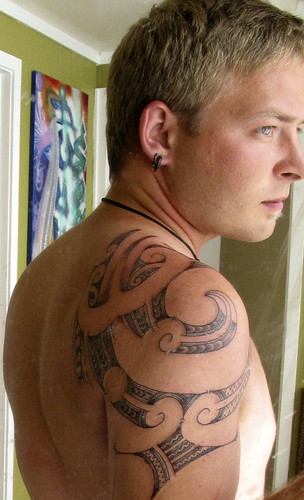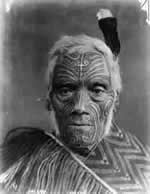


The word "tattoo" comes from the Tahitian word "tatau". Captain James Cook used the word "tattow" when he witnessed tattooing for the first time in Tahiti, in 1769.
According to Māori mythology, tattooing commenced with a love affair between a young man by the name of Mataora (which means "Face of Vitality") and a young princess of the underworld by the name of Niwareka.
One day however, Mataora beat Niwareka, and she left Mataroa, running back to her father's realm which was named "Uetonga".
Mataora, filled with guilt and heartbreak followed after his princess Niwareka. After many trials, and after overcoming numerous obstacles, Mataora eventually arrived at the realm of "Uetonga", but with his face paint messed and dirty after his voyage. Niwareka's family taunted and mocked Mataora for his bedraggled appearance. In his very humbled state, Mataora begged Niwareka for forgiveness, which she eventually accepted. Niwareka's father then offered to teach Mataora the art of tattooing, and at the same time Mataora also leant the art of Taniko - the plaiting of cloak borders in many colours.
Mataora and Niwareka thus returned together to the human world, bringing with them the arts of ta moko and taniko.
| Ta Moko, the process. Moko, the product |
| According to archaeological evidence, tattooing came to New Zealand from Eastern Polynesian culture. The bone chisels used for tattooing can be found in archaeological sites of various ages in New Zealand, as well as in some early Eastern Polynesian sites. Although the Māori practiced tattooing, there is no evidence that the Moriori people did. In New Zealand, It is in the early sites that the widest chisel blades are found, and this lends evidence to the theory that there was possibly a preference towards rectilinear tattoo patterns in earlier times. The head was considered the most sacred part of the body, and because tattooing caused blood to run the tattoo craftsmen, or "tohunga-ta-oko", were very tapu persons. All high-ranking Māori were tattooed, and those who went without tattoos were seen as persons of no social status. Tattooing commenced at puberty, accompanied by many rites and rituals. In addition to making a warrior attractive to women, the tattoo practice marked both rites of passage and important events in a person's life. There were certain prohibitions during the tattooing process, and for the facial tattoo in particular sexual intimacy and the eating of solid foods were prohibited. In order to overcome this, liquid food and water was drained into a wooden funnel, to ensure that no contaminating product came into contact with the swollen skin. This was also the only way the tattooed person could eat until his or her wounds healed. The full faced tattoo was very time consuming, and a good tattoo craftsman would carefully study a person's bone structure before commencing his art. |
 | Left : "Anehana, with full facial moko", circa 1900. Permission of the Alexander Turnbull Library, National Library of New Zealand Te Puna Mätaurangao Aotearoa, must be obtained before any reuse of this image. |
| The tattoo instrument was a bone chisel, either with a serrated or an extremely sharp straight edge. The first stage of the tattoo commenced with the graving of deep cuts into the skin. Next, a chisel was dipped into a sooty type pigment such as burnt Kauri gum or burnt vegetable caterpillars, and then tapped into the skin. |
| It was an extremely painful and long process, and often leaves from the native Karaka tree were placed over the swollen tattoo cuts to hasten the healing process. Wars were frequent, and the warriors had little time for recuperation. During the tattooing process, flute music and chant poems were performed to help soothe the pain. Although the tattoos were mainly facial, the North Auckland warriors included swirling double spirals on both buttocks, often leading down their legs until the knee. |
The women were not as extensively tattooed as the men. Their upper lips were outlined, usually in dark blue. The nostrils were also very finely incised. The chin moko was always the most popular, and continued to be practiced even into the 1970s.




No comments:
Post a Comment